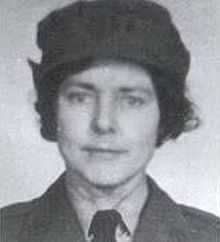Cecily Lefort
| Cecily Lefort | |
|---|---|
 Cecily Lefort | |
| Nickname | Agent Jockey, Alice |
| Born |
30 April 1900 London, England, United Kingdom |
| Died |
February 1945 (aged 44) Ravensbrück concentration camp, Germany |
| Allegiance | United Kingdom, France |
| Service/branch |
Special Operations Executive, Women's Auxiliary Air Force |
| Years of service | 1941-1942 (WAAF)/1942-1945 (SOE) |
| Unit | Jockey |
| Awards | Croix de Guerre, Mentioned in Dispatches |
Cecily Lefort (30 April 1900 – February 1945) was a British SOE agent during the Second World War.
Early life
Born as Cecily Margot MacKenzie in London of Scottish ancestry, she lived on the coast of Brittany in France from the age of 24 with her French husband, Dr. Alex Lefort.
Second World War
When the Second World War broke out, she and her husband fled occupied France for England, where they arranged for their home in Brittany to be available to the underground resistance for use as part of an escape line for downed British airmen and others needing to get out of occupied France. [citation needed]
In 1941, Lefort joined the British Women's Auxiliary Air Force. The following year, being fluent in the French language, she volunteered to serve with the F Section (France) of the Special Operations Executive based in London. On the night of 16 June 1943, with fellow SOE agents Diana Rowden and Noor Inayat Khan, she was flown to Le Mans, where they were met by Henri Dericourt. [citation needed] She was sent to southeastern France, where she was a courier for the "Jockey" network run by Francis Cammaerts. [citation needed]
On 15 September 1943, while meeting a contact in Montélimar in Drôme, Lefort was arrested by the Gestapo. After being subjected to a ruthless interrogation and torture, she was sent north to the Fresnes prison in Paris. Then, a few months later in early 1944, she was shipped to Ravensbrück concentration camp about 50 miles from Berlin. Ravensbrück had a gas chamber and crematorium; and, at the end of 1944, when the German defeat was imminent, the place became a frantic killing center.[1]
Held with 30,000 women and children, Lefort had to wear on her prison uniform the red triangle patch identifying her as a resistance worker. The prisoners were made to toil for hours doing such things as paving the streets by pulling a huge iron roller. Suffering from extreme malnutrition and exhaustion, Lefort was deemed by the Germans to no longer be of any value and she was gassed in February 1945. [citation needed]
Three other female members of the SOE were also executed at Ravensbrück: Denise Bloch, Lilian Rolfe, and Violette Szabo.
Honours
Cecily Lefort was Mentioned in Dispatches for her service to the British and honored by the government of France with a posthumous Croix de Guerre. She is recorded on the Runnymede Memorial in Surrey, England; and, as one of the SOE agents who died for the liberation of France, she is listed on the "Roll of Honor" on the Valençay SOE Memorial in Valençay, in the Indre departément of France.
References
- Squadron Leader Beryl E. Escott, Mission Improbable: A salute to the RAF women of SOE in wartime France, London, Patrick Stevens Ltd, 1991. ISBN 1-85260-289-9
- Liane Jones, A Quiet Courage: Women Agents in the French Resistance, London, Transworld Publishers Ltd, 1990. ISBN 0-593-01663-7
- Marucs Binney, The Women Who Lived for Danger: The Women Agents of SOE in the Second World War, London, Hodder and Stoughton, 2002. ISBN 0-340-81840-9
- Sarah Helm, A Life in Secrets: The Story of Vera Atkins and the Lost Agents of SOE, London, Abacus, 2005 ISBN 978-0-349-11936-6
- Germaine Tillion, Ravensbrück, Garden City, Anchor Press, 1975. ISBN 978-0-385-00927-0
- ↑
- Germaine Tillion, Ravensbrück, Garden City, Anchor Press, 1975. ISBN 978-0-385-00927-0